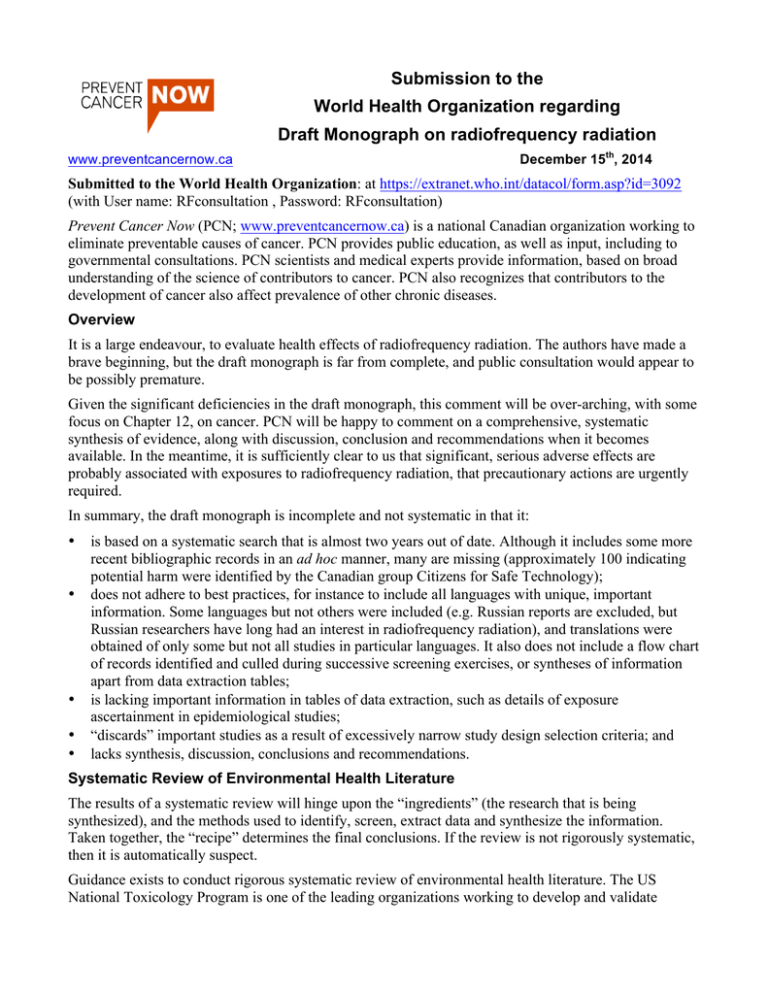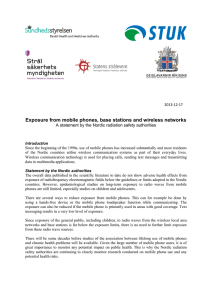World Health Organization
advertisement

Submission to the World Health Organization regarding Draft Monograph on radiofrequency radiation www.preventcancernow.ca December 15th, 2014 Submitted to the World Health Organization: at https://extranet.who.int/datacol/form.asp?id=3092 (with User name: RFconsultation , Password: RFconsultation) Prevent Cancer Now (PCN; www.preventcancernow.ca) is a national Canadian organization working to eliminate preventable causes of cancer. PCN provides public education, as well as input, including to governmental consultations. PCN scientists and medical experts provide information, based on broad understanding of the science of contributors to cancer. PCN also recognizes that contributors to the development of cancer also affect prevalence of other chronic diseases. Overview It is a large endeavour, to evaluate health effects of radiofrequency radiation. The authors have made a brave beginning, but the draft monograph is far from complete, and public consultation would appear to be possibly premature. Given the significant deficiencies in the draft monograph, this comment will be over-arching, with some focus on Chapter 12, on cancer. PCN will be happy to comment on a comprehensive, systematic synthesis of evidence, along with discussion, conclusion and recommendations when it becomes available. In the meantime, it is sufficiently clear to us that significant, serious adverse effects are probably associated with exposures to radiofrequency radiation, that precautionary actions are urgently required. In summary, the draft monograph is incomplete and not systematic in that it: • • • • • is based on a systematic search that is almost two years out of date. Although it includes some more recent bibliographic records in an ad hoc manner, many are missing (approximately 100 indicating potential harm were identified by the Canadian group Citizens for Safe Technology); does not adhere to best practices, for instance to include all languages with unique, important information. Some languages but not others were included (e.g. Russian reports are excluded, but Russian researchers have long had an interest in radiofrequency radiation), and translations were obtained of only some but not all studies in particular languages. It also does not include a flow chart of records identified and culled during successive screening exercises, or syntheses of information apart from data extraction tables; is lacking important information in tables of data extraction, such as details of exposure ascertainment in epidemiological studies; “discards” important studies as a result of excessively narrow study design selection criteria; and lacks synthesis, discussion, conclusions and recommendations. Systematic Review of Environmental Health Literature The results of a systematic review will hinge upon the “ingredients” (the research that is being synthesized), and the methods used to identify, screen, extract data and synthesize the information. Taken together, the “recipe” determines the final conclusions. If the review is not rigorously systematic, then it is automatically suspect. Guidance exists to conduct rigorous systematic review of environmental health literature. The US National Toxicology Program is one of the leading organizations working to develop and validate methods; they recently published results of a lengthy, extensive consultative refinement of review processes.1 The WHO document does not follow such guidance. For example, the draft monograph is lacking features such as a flowchart analogous to the CONSORT chart, of bibliographic records identified, screened, included and excluded (with reasons) at various screening and sorting levels (according to topic). Results are not synthesized, and even the summaries are not always reflective of the actual study. For example, exposure ascertainment in the Danish study was depicted as a strong point, when in fact some of the heaviest users of cell phones would have been misclassified. This study was highly criticized on the British Medical Journal website, by leading researchers, with compelling arguments. According to the methods section, systematic searches covered to the end of 2012. Some more recent studies have been included, but these are supplementary, chosen by the authors. The literature searches must be current, with an update conducted as close to the release date as possible. Over 20 months is definitely much too long a lag, particularly in a rapidly evolving field. Examples of research papers that should have been presented include:2,3 • • Carlberg, M., & Hardell, L. (2014). Decreased survival of glioma patients with astrocytoma grade IV (glioblastoma multiforme) associated with long-term use of mobile and cordless phones. International Journal of Environmental Research and Public Health, 11(10), 10790–10805. West JG, Kapoor NS, Liao S-Y, Chen JW, Bailey L, Nagourney RA. Multifocal Breast Cancer in Young Women with Prolonged Contact between Their Breasts and Their Cellular Phones. Case Rep Med. 2013 Sep 18;2013:e354682. The latter would have been excluded on the basis of study design – a case series of four young women with a distinctive type of breast cancer, located precisely where they habitually tucked their cell phones, in their bras. In rapidly evolving environmental health research, it is expected that early reports will be of lower quality study design. As recommended in the NTP guidance and elsewhere, the study design may be a factor in weighing of evidence, but the evidence cannot be excluded. Next steps It is obvious to ask the panel to update and continue drafting a Monograph, in the hopes that one of these years we will have a final document that is moderately (and temporarily) up to date. A pragmatic approach, however, would be to recognize that there are repeated observations of potential harm in epidemiological studies, backed up with mechanistic biological observations including altered membrane permeability, such as voltage-gated calcium channel effects. The commonly heard disclaimer that low levels that do not heat tissue are harmless because the radiation cannot ionize chemicals, misses the point. Every biochemical reaction in the body is catalyzed by enzymes, so ionization energies are irrelevant. Potential synergism of radiofrequency radiation in conjunction with toxic exposures has been observed in some in vitro studies, and most compellingly in a study of children were cell phone exposures affected behaviour only among those with higher lead levels.4 This is but one of many suggestive findings with profound, serious implications. Radiofrequency radiation increases accessibility across membranes for toxic chemicals, and would thereby magnify the effects of environmental contaminants. In the view of PCN, the risks are too high not to take precautionary actions at this stage. Materials are available at: www.preventcancernow.ca/wcds regarding reducing personal exposures. Actions at higher levels are necessary to: • • reduce recommended exposure limits; encourage safer devices (e.g. cable/wired internet connections; “eco” devices that do not continuously transmit to maintain contact with a base station, rather only transmit information); • limit wireless usage in particular places to provide low exposure, safer spaces and spaces particularly for children (e.g. daycares and schools). Sufficient review and pragmatic precautionary responses There is a concern that WHO resources are not adequate for this task. As discussed in a Time Magazine article,5 the response to Ebola was too little too late to avert or minimize a public health disaster. Effects of radiofrequency radiation would be on a longer time scale. Unfortunately, a slow-motion disaster is even less likely to receive the urgent, definitive response needed to avert disability, illness and death as a result of frivolous over-use of a type of technology for which we have many alternatives and potential for greater safety. Delay may mean increased profits for wireless technologies, but also means mounting numbers of people, particularly the young, at risk of cancers and other conditions. PCN thanks the WHO for undertaking an evaluation of health effects of radiofrequency radiation. Honestly, with the increasing rate of research and conflicts of interest, this task will never be complete. In the meantime, countries such as Canada are postponing actions, awaiting the WHO document. We respectfully ask for serious consideration of actions at this stage. Sincerely Meg Sears PhD Co-chair, Prevent Cancer Now meg@preventcancernow.ca References 1. Rooney AA, Boyles AL, Wolfe MS, Bucher JR, Thayer KA. Systematic Review and Evidence Integration for Literature-­‐Based Environmental Health Science Assessments. Environ Health Perspect [Internet]. 2014 Apr 22 [cited 2014 Apr 24]; Available from: http://ehp.niehs.nih.gov/1307972 2. Carlberg M, Hardell L. Decreased Survival of Glioma Patients with Astrocytoma Grade IV (Glioblastoma Multiforme) Associated with Long-­‐Term Use of Mobile and Cordless Phones. Int J Environ Res Public Health. 2014 Oct 16;11(10):10790–805. 3. West JG, Kapoor NS, Liao S-­‐Y, Chen JW, Bailey L, Nagourney RA. Multifocal Breast Cancer in Young Women with Prolonged Contact between Their Breasts and Their Cellular Phones. Case Rep Med. 2013 Sep 18;2013:e354682. 4. Byun Y-­‐H, Ha M, Kwon H-­‐J, Hong Y-­‐C, Leem J-­‐H, Sakong J, et al. Mobile Phone Use, Blood Lead Levels, and Attention Deficit Hyperactivity Symptoms in Children: A Longitudinal Study. PLoS ONE [Internet]. 2013 Mar 21 [cited 2014 Jul 4];8(3). Available from: http://www.ncbi.nlm.nih.gov/pmc/articles/PMC3605379/ 5. Walt V. WHO Chief Says Ebola Response “Did Not Match” Scale of the Outbreak. Time [Internet]. 2014 Oct 30 [cited 2014 Dec 15]; Available from: http://time.com/3548096/ebola-­‐ world-­‐health-­‐organization-­‐margaret-­‐chan/
